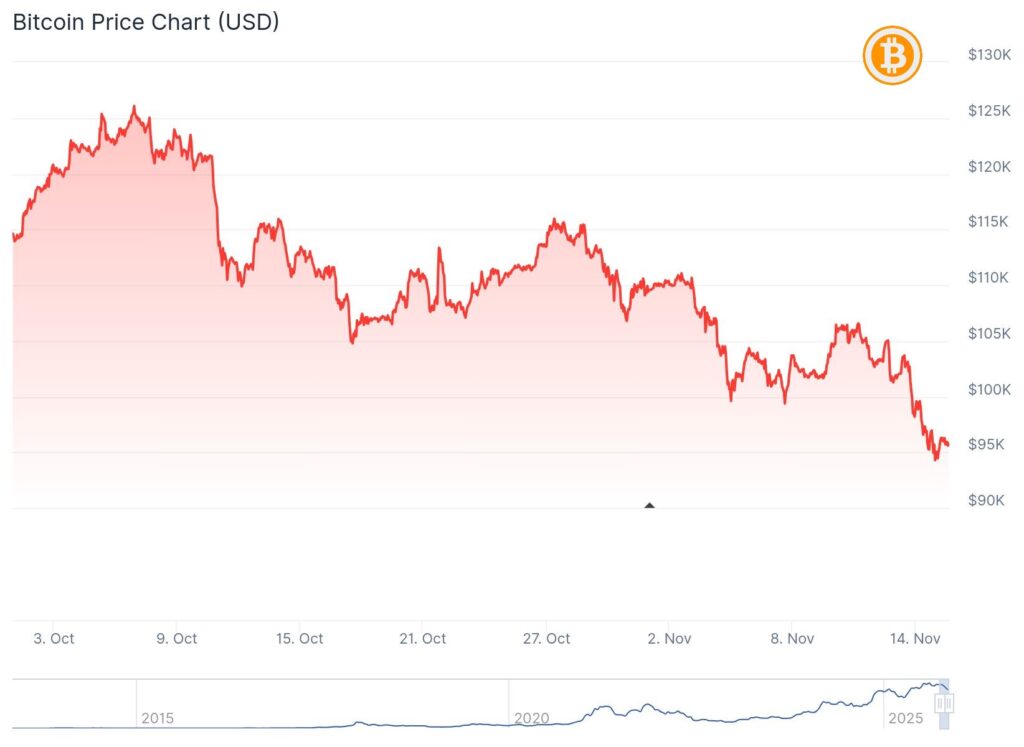Estimated reading time: 3 minutes
TL;DR
- Bitcoin fell below $95K due to high interest rates, shifting Fed expectations, and reduced liquidity after the U.S. shutdown.
- Institutional selling and ETF outflows added pressure, while global uncertainty pushed investors toward safer assets.
- Key levels to watch: $94K–$92K support and $100K resistance.
Bitcoin’s price fell below $95,000 this week, marking its lowest level in six months and raising fresh concerns among investors. Many people are asking the same question: why is Bitcoin falling? This article explains the key factors behind the Bitcoin price drop in November 2025 in clear, simple terms.
What Happened to Bitcoin’s Price?
Bitcoin has lost around 9% over the past week. Earlier this month, it briefly climbed above $100,000, but the momentum didn’t last. The price slipped back toward the $94,000–$95,000 range, reflecting a wider pullback across riskier assets. Tech stocks, altcoins, and other speculative investments have also been under pressure, showing that this move is part of a broader recent selloff rather than a Bitcoin-only event.

The Federal Reserve’s Role
A major driver of the drop is the shift in expectations around U.S. interest rates. The Federal Reserve controls borrowing costs, and when rates stay high, it becomes more expensive for both consumers and businesses to access credit. That typically reduces appetite for high-risk assets like Bitcoin.
Just weeks ago, many investors expected the Fed to cut rates in December. Now, the odds look closer to 50/50. This uncertainty has cooled demand across the crypto market. The change highlights the Federal Reserve impact on Bitcoin: when interest-rate cuts seem unlikely, prices often weaken.
How the U.S. Government Shutdown Played a Role
The recent 43-day U.S. government shutdown also contributed to market pressure. Even though the government surprisingly ran a temporary fiscal surplus during the shutdown, it reduced the flow of money through the economy. With less liquidity available, there were simply fewer buyers in the market. That lack of cash made assets like Bitcoin more vulnerable to downward moves.
Now that the government has reopened, analysts expect liquidity to improve, which could help stabilize prices in the coming weeks.
Institutional Selling and ETF Outflows
Large investors have also been taking profits or selling to cover other losses, adding to the decline. These moves have a bigger impact because institutional trades often involve large amounts of Bitcoin. In addition, some U.S. crypto ETFs saw outflows in November as investors pulled money out, further increasing selling pressure on Bitcoin.
Global Uncertainty Isn’t Helping
Broader concerns about slow economic growth in China and ongoing geopolitical tensions have made investors more cautious. When global conditions feel shaky, people tend to move away from riskier assets and into safer options like gold, dollars, or government bonds.
What Does This Mean for Bitcoin Investors?
The Bitcoin price drop in November 2025 doesn’t necessarily signal the start of a long bear market. It may be a short-term reaction to rate expectations, liquidity issues, and market nerves. Key levels to watch are $94,000–$92,000 on the downside and $100,000 as the next major barrier.
For some investors, dips like these are a chance to buy. For others, they are a reminder of how sensitive Bitcoin is to shifts in economic conditions. Either way, understanding the main reasons behind Bitcoin’s recent selloff helps put the move into perspective.










